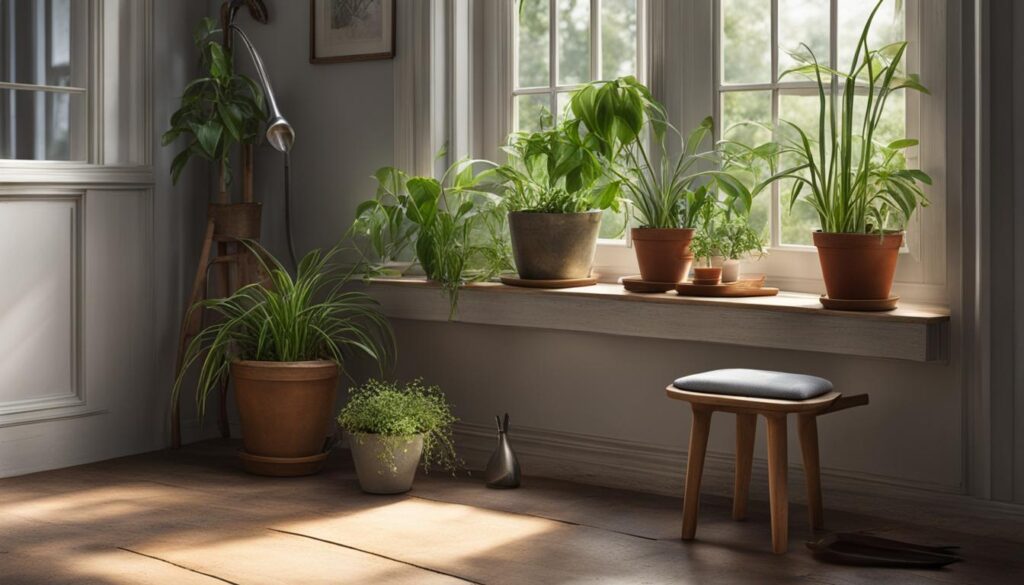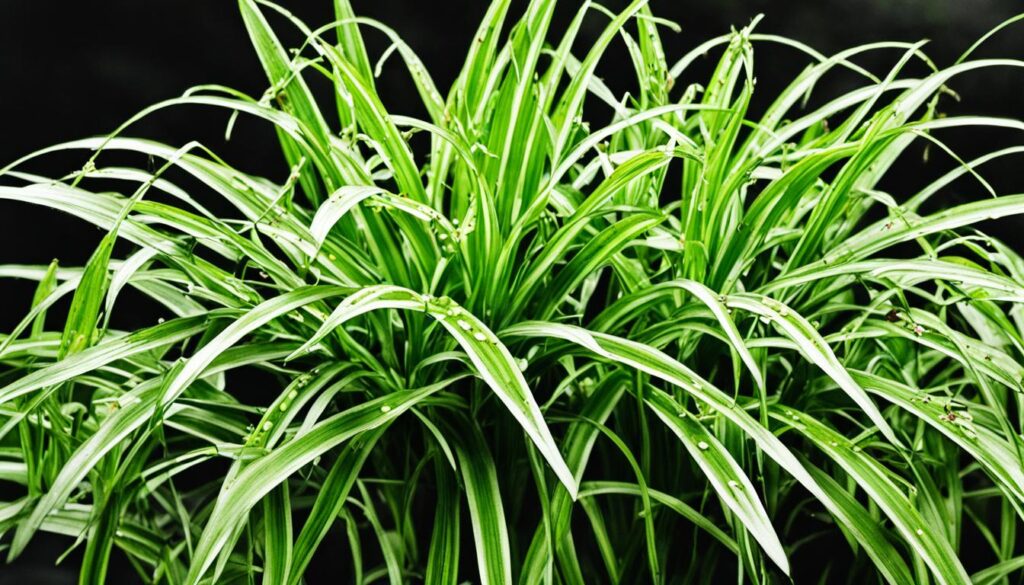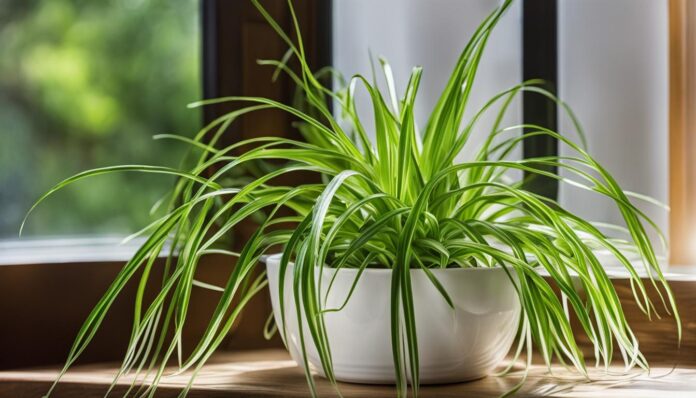Spider plants are an excellent choice for indoor greenery enthusiasts. With their elegant long, thin foliage, spider plants add a touch of sophistication to any space. Not only are they visually appealing, but they also serve as natural air purifiers, improving the air quality in your home. In this comprehensive guide, we will provide you with all the information you need to successfully grow and care for spider plants indoors.
Key Takeaways
- Spider plants are low-maintenance houseplants that can add a touch of elegance to any indoor space.
- They are known for their air-purifying abilities, making them a great choice for those looking to improve the air quality in their homes.
- Spider plants thrive in soil-based potting mix and require bright to moderate indirect sunlight.
- Proper watering, temperature, and regular maintenance are key to keeping spider plants healthy and thriving.
- Spider plants can be easily propagated through their “pups,” allowing you to expand your collection or share with others.
About Spider Plants
Spider plants, also known as Chlorophytum comosum, are popular indoor plants named for their long stems that produce tiny white flowers and “pups,” which resemble tiny spiders. These plants were once highlighted by NASA for their reported air-purifying ability, although it would require a large number of plants to make a significant impact on indoor air quality. Nonetheless, spider plants remain a classic and attractive choice for any indoor space.
Spider plants have been enjoyed for centuries and were especially popular in Victorian-era households. Their elegant, arching foliage and ability to thrive in various light conditions make them versatile additions to any room. Whether placed in a hanging basket, on a table, or on a stand, spider plants bring a touch of natural beauty and freshness to any space.
“Spider plants are not only visually appealing but also have air-purifying abilities, making them an ideal choice for homes and offices.” – PlantLoverMagazine
The distinctive appearance and low-maintenance nature of spider plants have made them a favorite among plant enthusiasts and beginners alike. They are not only aesthetically pleasing but also provide several health benefits, including improving air quality and reducing stress levels.
The Benefits of Spider Plants
- Attractive foliage: Spider plants have long, thin, arched leaves that can be solid green or variegated with white, adding a touch of elegance to any room.
- Air-purifying ability: While spider plants are not the most potent air purifiers, they can help remove certain pollutants and increase oxygen levels in an indoor environment.
- Low-maintenance: Spider plants are incredibly easy to care for, requiring minimal watering and can tolerate various light conditions.
- Promote relaxation: The presence of plants, including spider plants, can help reduce stress levels and create a calm and soothing atmosphere in your home or office.
- Easy propagation: Spider plants produce “pups” that can be easily propagated and shared with friends or distributed throughout your space for a lush, green look.
Spider plants are not only beautiful but also provide numerous benefits, making them an excellent choice for any indoor plant collection. Whether you’re an experienced plant enthusiast or just starting your gardening journey, spider plants are sure to bring joy and natural elegance to your home.
Planting Spider Plants
To ensure the successful growth of your spider plants, proper planting techniques are essential. Follow these guidelines to provide the ideal conditions for your spider plants to thrive.
Soil-based Potting Mix
Spider plants prefer a soil-based, well-draining potting mix. It is important to choose a mix that provides excellent drainage to prevent waterlogging, which can lead to root rot. A high-quality potting mix enriched with organic matter will provide the necessary nutrients for healthy plant growth.
Even Moisture
Spider plants require even moisture to maintain their health and vitality. Avoid overwatering, as their root system is susceptible to rot in waterlogged conditions. Allow the top inch of soil to dry between waterings, and always water thoroughly to ensure the entire root ball is hydrated.
Bright to Moderate Indirect Sunlight
Place your spider plants in a location with bright to moderate indirect sunlight. Direct, hot sunlight can scorch the leaves and cause damage. If you notice leaf burn or discoloration, move the plant to a slightly shadier spot.
Repotting Every Other Year
Spider plants are fast growers and tend to become pot-bound over time. To ensure their continued growth and development, it is recommended to repot them every other year. This allows the roots to have enough space and promotes healthy growth.
Outdoor Growth as Annuals
Spider plants can also be grown outdoors as annuals during the summer months, adding a touch of greenery to your outdoor spaces. However, they should be protected from direct sunlight, as excessive heat can harm the plants. Consider placing them in a shaded area or under a tree canopy to provide the right amount of light and protection.
By following these planting guidelines, you will create the ideal environment for your spider plants to flourish. Let’s move on to the next section to discover how to care for these beautiful houseplants.

Growing Spider Plants
Spider plants require specific care in order to thrive and grow to their full potential. By following these guidelines for watering, temperature maintenance, and fertilizing, you can ensure that your spider plant remains healthy and vibrant.
Watering
Moderate watering is essential for spider plants. During their initial growth stage, they should be watered occasionally. However, once they are fully developed, it is best to water them moderately. Overwatering can lead to root rot, so it is important to allow the soil to dry slightly between waterings.
Average Room Temperature
To promote optimal growth, spider plants prefer average room temperature and humidity. Temperatures between 55 and 80°F (13–27°C) are ideal for these plants. It is important to avoid exposing spider plants to extreme heat or cold, as they are sensitive to temperature fluctuations.
Fertilizing in Spring and Summer
Spider plants benefit from regular fertilization during the spring and summer months when they are actively growing. Fertilize your spider plant twice a month using a balanced liquid fertilizer diluted to half the recommended strength. Be careful not to overfertilize, as this can lead to salt buildup and damage the plant’s roots.
| Watering | Temperature | Fertilizing |
|---|---|---|
| Moderate watering | Maintain average room temperature (55-80°F) | Fertilize twice a month in spring and summer |
Remember, spider plants are resilient, adaptable, and relatively low-maintenance. By providing moderate watering, maintaining average room temperature, and fertilizing in spring and summer, you can ensure that your spider plant thrives and adds a touch of greenery to your indoor space.
Recommended Varieties of Spider Plants
Spider plants are known for their beautiful foliage, which can come in various forms and colors. If you’re looking to add some variety to your indoor garden, consider these recommended spider plant varieties:
1. Variegated Forms
The variegated forms of spider plants are the most common and popular varieties. These plants feature leaves with a mix of green and white, creating a visually striking contrast. The variegation can be in the form of a single off-white stripe down the center of each leaf or an off-white stripe running along the edge of each green leaf.
2. ‘Vittatum’
The ‘Vittatum’ spider plant variety is characterized by its green foliage with a single off-white stripe down the center of each leaf. This variety adds elegance and interest to any indoor space with its unique color pattern.
3. ‘Variegatum’
The ‘Variegatum’ spider plant variety has an off-white stripe running along the edge of each green leaf. This distinctive feature sets it apart from other spider plant varieties and adds a touch of sophistication to your indoor garden.
4. Solid Green Varieties
If you prefer a simpler and more classic look, there are also solid green spider plant varieties available. These plants have lush, green foliage without any variegation, creating a sense of tranquility and harmony in your indoor space.
Whether you choose a variegated form, ‘Vittatum’, ‘Variegatum’, or a solid green variety, spider plants are sure to add beauty and vibrancy to your indoor garden. Experiment with different varieties to create a stunning display of spider plants in your home.
Harvesting Spider Plants
Once your spider plant has reached maturity, it will begin to produce small offshoots called “pups.” These pups can be harvested and replanted to start new spider plants, allowing you to propagate and expand your collection. Harvesting spider plant pups is a straightforward process that can be done in a few simple steps.
Step 1: Pup Selection
Before harvesting the pups, it’s important to select the right ones for propagation. Look for pups that are approximately two inches in diameter and have their own set of roots. These pups are more likely to thrive when replanted.
Step 2: Separation
To separate the pups from the mother plant, gently grasp the base of the pup and wiggle it back and forth until it detaches. Be careful not to damage the roots of the pup or the main plant during this process.
Step 3: Replanting
Once the pups have been separated, they can be replanted in their own pots or containers. Fill the pots with a well-draining potting mix and create a small hole for each pup. Place the pup in the hole and gently press the soil around it to secure it in place. Water the newly planted pup lightly to settle the soil.
Alternatively, if you prefer to keep the pups attached to the mother plant until they root themselves, you can place them in pots of soil next to the main plant. Once the pups have formed their own roots, they can be cut loose from the mother plant and grown as individual spider plants.
Harvesting and propagating spider plant pups is a rewarding way to expand your spider plant collection and share these beautiful plants with others. With a little care and patience, you’ll soon have a thriving spider plant family.
| Benefits of Harvesting Spider Plant Pups | Tips for Successful Harvesting |
|---|---|
|
|
Pests and Diseases of Spider Plants
While spider plants are generally resilient and low-maintenance, they can still fall victim to certain pests and diseases. Understanding these potential issues and taking proactive measures to prevent and address them is crucial for maintaining the health and vitality of your spider plant.
Tips to Prevent Tip Burn
One common problem that spider plant owners encounter is tip burn, characterized by browning and withering of the leaf tips. Tip burn can occur due to various factors, including:
- Dry soil: Spider plants prefer slightly moist soil, so ensure that the soil is adequately watered without becoming waterlogged.
- Low humidity: Spider plants thrive in environments with moderate humidity levels. If the air in your home is particularly dry, consider using a humidifier or placing a tray of water near the plant to increase humidity.
- Fluoride and chlorinated water: Tap water containing fluoride or chlorine can be detrimental to spider plants. To prevent tip burn, use filtered or distilled water instead.
Pest Infestations: Mealybugs and Scale
Spider plants are also susceptible to infestations by common indoor plant pests, such as mealybugs and scale. These pests feed on the sap of the plant and can weaken its overall health if left untreated. Look out for the following signs of pest infestations:
- Mealybugs: Mealybugs appear as small, white, cottony clusters on the leaves, stems, and undersides of spider plants. They can damage the plant by sucking the sap and causing wilting and distorted growth.
- Scale: Scale insects often appear as small, brown or black bumps on the leaves and stems of spider plants. They can cause yellowing, wilting, and premature leaf drop if not controlled.
If you notice signs of mealybug or scale infestation, take immediate action to eliminate the pests:
- Isolate the affected plant from other healthy plants to prevent the infestation from spreading.
- Remove visible pests manually using a cotton swab or a soft brush dipped in rubbing alcohol.
- For severe infestations, consider using an organic insecticidal soap or neem oil spray as directed.
Regularly inspecting your spider plant for signs of pests and promptly addressing any infestations will help keep your plant healthy and thriving.

Spider Plant Care Tips
Proper care is essential to keep your spider plant healthy and thriving. Understanding the watering frequency, light requirements, temperature tolerance, and maintenance needs of your spider plant will help you create an optimal environment for its growth.
Watering Frequency
To prevent overwatering, which can lead to root rot, it’s important to water your spider plant lightly. Allow the top inch of soil to dry out before watering again. During the spring and summer months when the plant is actively growing, you can water it every week or so. However, during autumn and winter, when growth slows down, reduce the watering frequency to every two to three weeks.
Light Requirements
Spider plants are highly adaptable when it comes to light conditions. While they can tolerate low light situations, they prefer bright spots with indirect sunlight. Avoid placing your spider plant in direct sunlight as it can scorch the leaves. If you notice the foliage becoming pale or the plant stretching towards the light source, it may be an indication that it needs more light.
Temperature Tolerance
Spider plants have a wide temperature tolerance range, but they thrive in average room temperatures between 55 and 80°F (13–27°C). Avoid exposing your plant to extreme heat or cold. Protect it from drafts and keep it away from heating or cooling vents that could cause temperature fluctuations.
Maintenance
Maintaining your spider plant involves a few simple tasks that will keep it looking its best. Here are some maintenance tips:
- Snip off any brown or yellowing tips to promote healthy growth and maintain a tidy appearance.
- Occasionally mist the leaves with water to increase humidity, especially in dry indoor environments.
- Wipe off the leaves using a damp cloth to remove dust, which can hinder the plant’s ability to photosynthesize.
In addition to regular care, feeding your spider plant with a liquid fertilizer once a month during the spring and summer months can provide a growth boost. Be sure to follow the instructions on the fertilizer packaging for proper dilution and application.
| Watering Frequency | Light Requirements | Temperature Tolerance | Maintenance |
|---|---|---|---|
| Water lightly every week or so, reducing frequency in autumn and winter | Tolerates various light conditions; prefers bright spots with indirect sunlight | Thrives in average room temperatures between 55 and 80°F (13–27°C); protect from extreme heat and frost | Snip off brown tips, mist leaves occasionally, wipe off dust, apply liquid fertilizer once a month in spring and summer |
Fun Facts about Spider Plants
Spider plants are fascinating houseplants that belong to the botanical classification Chlorophytum comosum. Their adaptability is one of their standout features, making them a popular choice for indoor gardening enthusiasts. These plants are known to thrive in various indoor conditions, making them suitable for almost any home environment.
One of the reasons spider plants are prized by plant owners is their ability to propagate easily. Mature spider plants produce small offshoots known as “spiderettes” or “pups.” These spiderettes can be cut off from the parent plant and planted in separate pots to grow into new plants. This propagation method is simple and allows you to expand your plant collection or share spider plants with friends and family.
Whether you’re a beginner gardener or a seasoned plant enthusiast, spider plants are a fantastic choice. Their adaptability and ease of propagation make them an excellent addition to any indoor garden. So, if you’re looking for a low-maintenance, visually appealing plant that you can easily multiply, spider plants are the perfect choice.
FAQ
Are spider plants difficult to grow?
No, spider plants are known for being easy to grow and low-maintenance houseplants.
Do spider plants improve indoor air quality?
Yes, spider plants are air-purifying plants that can help improve the air quality in your home.
How often should I water spider plants?
Spider plants should be watered occasionally during their initial growth stage and moderately once they are fully developed.
What is the ideal temperature for spider plants?
Spider plants prefer average room temperature and humidity, with temperatures between 55 and 80°F (13–27°C) being ideal.
Can spider plants be grown outdoors?
Yes, spider plants can be grown outdoors as annuals during the summer, as long as they are protected from direct sunlight.
How do I propagate spider plants?
Spider plants produce “pups” which can be removed and replanted to start new plants, or left attached to the mother plant until they root themselves.
How do I prevent tip burn on spider plants?
To prevent tip burn, keep the soil slightly moist, avoid watering with fluoridated or chlorinated water, and maintain adequate humidity.
What are the common pests and diseases of spider plants?
Spider plants can be affected by pests such as mealybugs and scale. Prompt treatment is necessary to maintain the plant’s health.
How often should I fertilize spider plants?
Spider plants should be fertilized twice a month in the spring and summer, but overfertilization should be avoided.
What are the recommended varieties of spider plants?
The most common varieties of spider plants are the variegated forms, such as ‘Vittatum’ with a central white stripe and ‘Variegatum’ with an edge white stripe.

